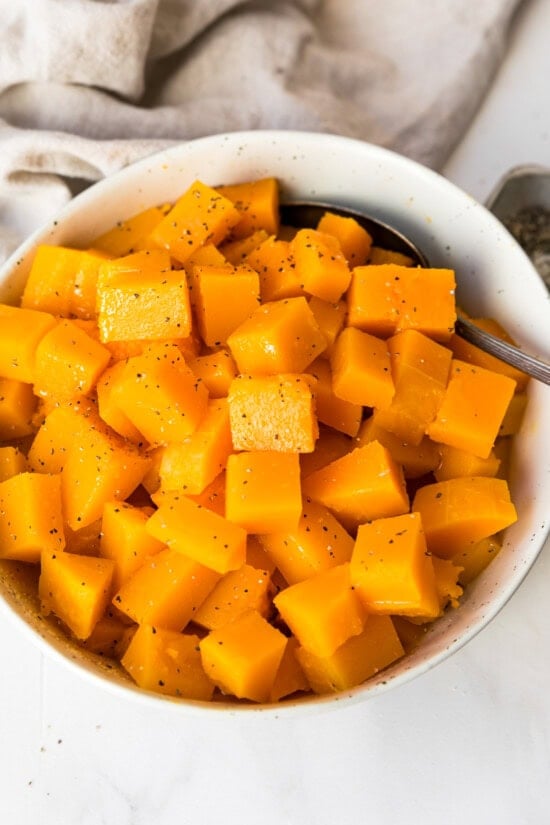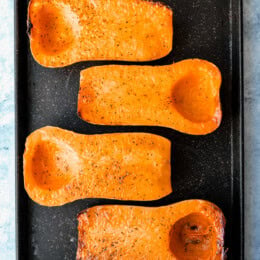The easiest recipe for roasted butternut squash (no need to peel)! Enjoy as a side dish, add to salad, turn into soup, pasta sauce, etc.

How To Roast Butternut Squash
Everyone needs a back-pocket recipe for a whole roasted butternut squash because it’s one of the easiest, most versatile dishes to prepare. With minimal effort, you get a beautifully caramelized, tender squash that’s perfect for so many meals. Roast it whole, and then slice or scoop it to serve as a side, mash it for soups, or use it in salads, grain bowls, and even tacos. The natural sweetness of the squash intensifies during roasting, making it a flavorful and nutritious base that’s packed with vitamins, fiber, and earthy goodness. Plus, it requires no peeling or fuss – just roast and enjoy!
And if you need instructions for preparing other winter squashes, I also have recipes for Roasted Acorn Squash with Brown Sugar, Roasted Spaghetti Squash, and Honeynut Squash with Maple and Pecans.
What You’ll Need
This simple roasted butternut squash recipe has only 4 ingredients, and 3 are pantry staples! The recipe card below provides the exact measurements.

- Butternut Squash: Cut the squash in half and scoop out the seeds. (Check out my easy tip for cutting butternut squash if you’re having a hard time.)
- Extra Virgin Olive Oil prevents the squash from drying out and enhances the flavor.
- Seasoning: Keep it simple with kosher salt and black pepper.
How to Roast Butternut Squash
After you prep the squash, the rest of the cooking time is hands-off. Find the complete instructions in the recipe card below.



- Prep the Squash: Rub the flesh of the squash halves with oil and sprinkle with salt and pepper. Lay the squash cut side down on a rimmed baking sheet sprayed with oil.
- How Long to Roast Butternut Squash Halves: Roast butternut squash at 425°F for 40 to 45 minutes until you can pierce the flesh easily with a fork.
Variations
- Seasonings: Add other spices like cinnamon, cumin, or chili powder.
- Oil: Avocado or coconut oil will also work.
How to Serve Roasted Butternut Squash
- Cube It: Scoop the squash out of the skins and cube it. Season it with more salt and serve with a little butter and maple syrup. Eat it as a side with roasted chicken or pork chops.
- Mashed: Swap potatoes in this mashed sweet potato recipe for butternut.
- Salad: Add cubed squash to kale salads with fall fruit, such as pomegranates, apples, or pears.
- Butternut Squash Soup: I have so many versions, like this Butternut Squash Lentil Soup and Coconut Curry Butternut Squash Soup.
- Creamy Pasta Sauce: Turn the roasted squash into a nutritious sauce, as I did with this Spicy Butternut Squash Pasta or Butternut Leek Parmesan Sauce.
Storage
Roasted butternut squash can be stored in the refrigerator for up to 4 days. To reheat it, air fry, microwave, or bake it in the oven.
FAQ
If you’re cubing butternut squash, you should peel it first. However, if roasting
butternut squash halves, don’t peel it. That’s why I find this to be the easiest method. The skin will keep the squash intact.
You can do it either way, but I prefer putting the cut side down (i.e., skin side up).

More Butternut Squash Recipes You’ll Love
- Maple Roasted Butternut Squash
- Air Fryer Butternut Squash
- Kale and Butternut Squash Salad with Pears and Almonds
- Stuffed Butternut Squash with Wild Rice and Sausage
- Maple Soy Glazed Roasted Brussels Sprouts and Butternut Squash
Roasted Butternut Squash

Ingredients
- 2 large butternut squash, halved lengthwise, seeds scooped out and discarded (about 2 1/2 lbs)
- 1 tablespoon extra virgin olive oil
- 1/2 teaspoon kosher salt
- fresh ground pepper, to taste
Instructions
- Preheat the oven to 425F. Spray a large sheet pan with oil.
- Rub the flesh of the squash halves with olive oil and season with salt and black pepper. Lay the squash halves, cut side down on a rimmed sheet pan. Roast until you can pierce the flesh easily with a fork, about 40 to 45 minutes.
- Scoop it out and serve.
- This can be cubed and seasoned with more salt and served with a little butter and maple syrup, mashed in place of mashed potatoes, pureed, added to salads, or turned into butternut squash soup or a butternut squash sauce for pasta.





